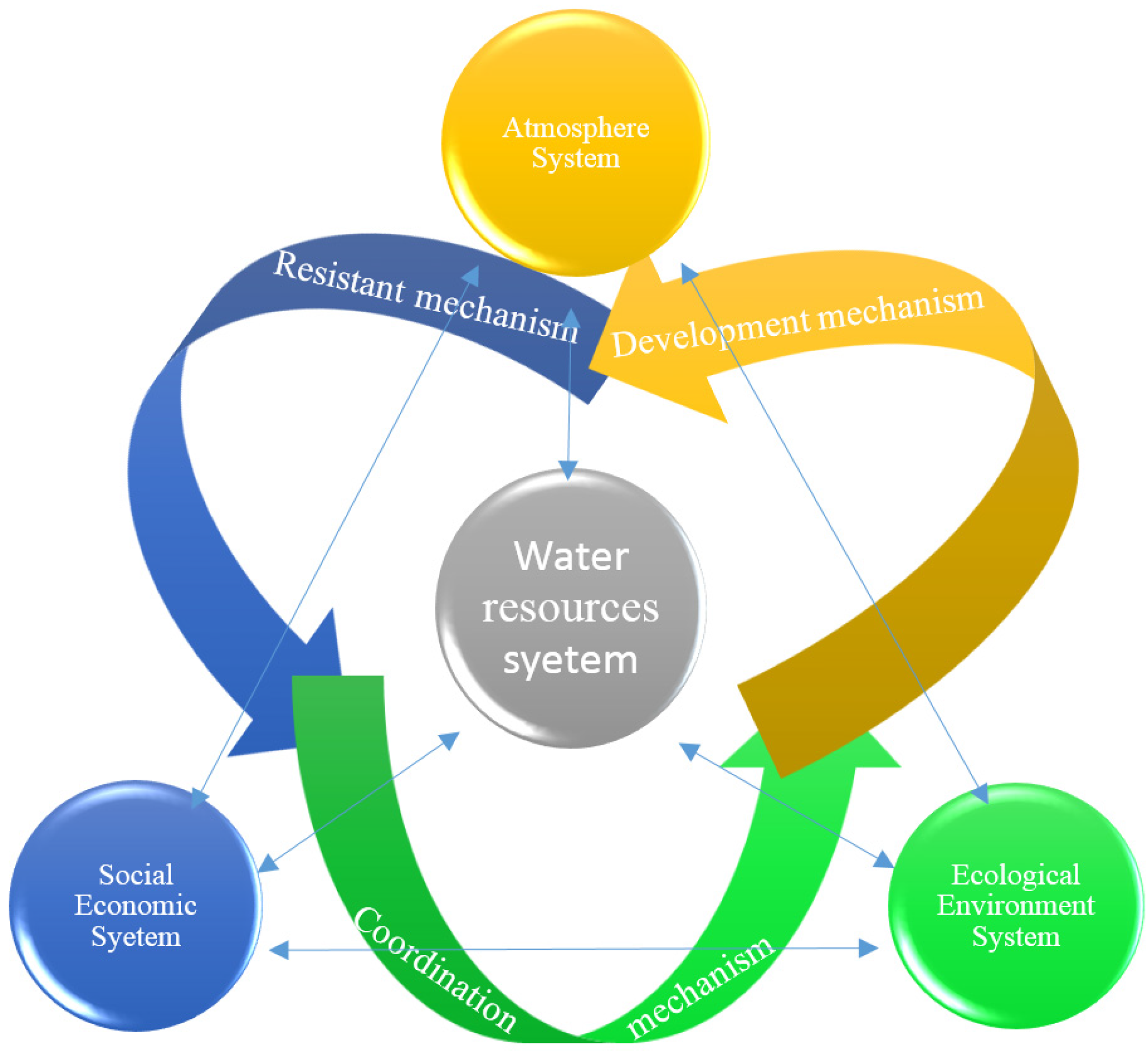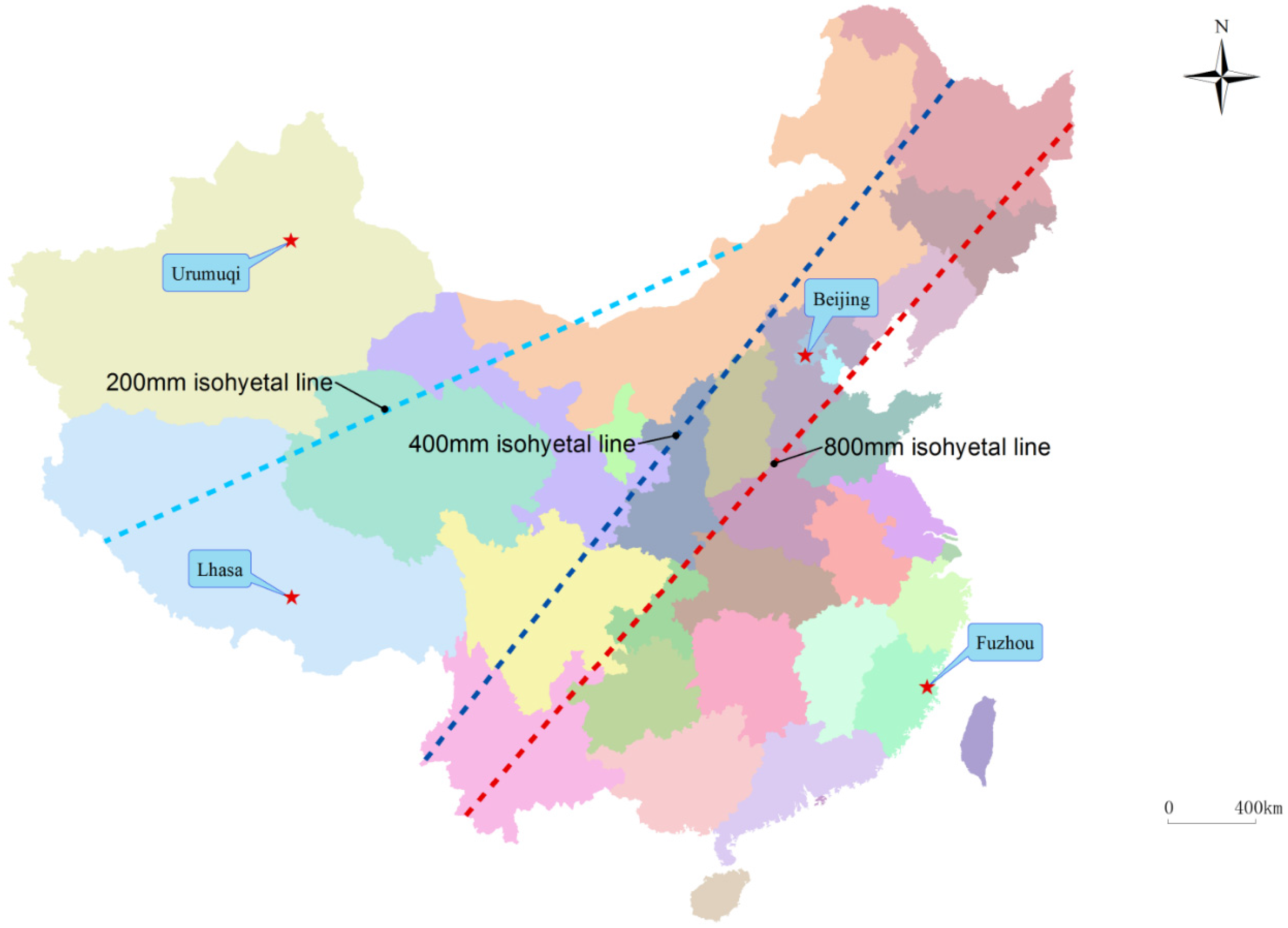Water Resources Compound Systems: A Macro Approach to Analysing Water Resource Issues under Changing Situations
Abstract
:1. Introduction
2. Materials and Methods
2.1. Water Resources Compound System

2.2. Mechanisms of Water Resources Compound System
2.3. Calculating the Water Quotient
| Subsystem | Indicator | Indicator Type |
|---|---|---|
| Water Resources System | Volume of sewage emission per capita (L/people day) | cost |
| Water consumption per 10,000 Yuan RMB in GDP (m3/10,000Yuan) | cost | |
| Total volume of water resources (m3) | efficiency | |
| Volume of water resources per capita (m3/people) | efficiency | |
| Atmosphere System | Aridity Index | cost |
| High temperature days (day) | cost | |
| Annual precipitation (mm) | efficiency | |
| Annually average relative humidity (%) | efficiency | |
| Social Economic System | Population growth rate (%) | cost |
| Population density (people/km2) | cost | |
| Investment in wastewater treatment (10,000 Yuan) | efficiency | |
| Per capita GDP (Yuan) | efficiency | |
| Ecological Environment System | Average concentration of ammonia nitrogen in water (mg/L) | cost |
| Annual concentration of PM2.5 (μg/m3) | cost | |
| Ecological Index | efficiency | |
| Eco-environmental water consumption rate (%) | efficiency |
2.4. Case Study

3. Results and Discussion
| Subsystem | Indicator | Beijing | Fuzhou | Urumqi | Lhasa |
|---|---|---|---|---|---|
| Water Resources System | Volume of sewage emission per capita (L/people⋅day) | 201 | 164 | 124 | 131 |
| Water consumption per 10,000 Yuan RMB in GDP (m3/10,000Yuan) | 18.67 | 66.35 | 17.80 | 101.36 | |
| Total volume of water resources (m3) | 24.81 | 86.04 | 13.22 | 82.03 | |
| Volume of water resources per capita (m3/people) | 118.60 | 1240 | 502.80 | 2367.73 | |
| Atmosphere System | Aridity Index | 1.40 | 0.50 | 1.60 | 2.40 |
| High temperature days (day) | 10 | 41 | 7 | 0 | |
| Annual precipitation (mm) | 501 | 1393.90 | 294 | 565.20 | |
| Annually average relative humidity (%) | 53.33 | 75.67 | 60.67 | 37.25 | |
| Social Economic System | Population growth rate (%) | 2.19 | 1.56 | 1.99 | 1.53 |
| Population density (people/km2) | 1289 | 556 | 188 | 20 | |
| Investment in wastewater treatment (10,000 Yuan) | 613.08 | 127.79 | 31.07 | 28.69 | |
| Per capita GDP (Yuan) | 93,213 | 70,302 | 83,781 | 9006 | |
| Ecological Environment System | Average concentration of ammonia nitrogen in water (mg/L) | 10.10 | 5.30 | 8.90 | 1.70 |
| Annual concentration of PM2.5 (μg/m3) | 88.30 | 31.40 | 87 | 23.60 | |
| Ecological Index | 66 | 73 | 59 | 63 | |
| Eco-environmental water consumption rate (%) | 1.80 | 4.20 | 0.90 | 1.20 |
| City | Beijing | Fuzhou | Urumqi | Lhasa |
|---|---|---|---|---|
| Development Mechanism | 0.4114 | 0.6005 | 0.4089 | 0.5057 |
| Resistant Mechanism | 0.6049 | 0.4644 | 0.4779 | 0.4191 |
| Coordination Mechanism | 0.6309 | 0.7719 | 0.6369 | 0.6989 |
| Coupling Degree | 0.9676 | 0.9923 | 0.9919 | 0.9660 |
| Water Quotient | 0.4292 | 0.9983 | 0.5449 | 0.8433 |



4. Conclusions
Acknowledgments
Author Contributions
Conflicts of Interest
References
- Christensen, N.S.; Wood, A.W.; Voisin, N.; Lettenmaier, D.P.; Palmer, R.N. The effects of climate change on the hydrology and water resources of the colorado river basin. Clim. Chang. 2004, 62, 337–363. [Google Scholar] [CrossRef]
- Jackson, R.B.; Carpenter, S.R.; Dahm, C.N.; McKnight, D.M.; Naiman, R.J.; Postel, S.L.; Running, S.W. Water in a changing world. Ecol. Appl. 2001, 11, 1027–1045. [Google Scholar] [CrossRef]
- Jury, W.A.; Vaux, H.J., Jr. The emerging global water crisis: Managing scarcity and conflict between water users. Adv. Agron. 2007, 95, 1–76. [Google Scholar]
- Vorosmarty, C.J.; Green, P.; Salisbury, J.; Lammers, R.B. Global water resources: Vulnerability from climate change and population growth. Science 2000, 289, 284–288. [Google Scholar] [CrossRef] [PubMed]
- Gleick, P.H. Water in crisis: Paths to sustainable water use. Ecol. Appl. 1998, 8, 571–579. [Google Scholar] [CrossRef]
- Duda, A.M.; El-Ashry, M.T. Addressing the global water and environment crises through integrated approaches to the management of land, water and ecological resources. Water Int. 2000, 25, 115–126. [Google Scholar] [CrossRef]
- Rudestam, K.; Langridge, R. Sustainable yield in theory and practice: Bridging scientific and mainstream vernacular. Groundwater 2014, 52, 90–99. [Google Scholar] [CrossRef] [PubMed]
- Sophocleous, M. From safe yield to sustainable development of water resources—The kansas experience. J. Hydrol. 2000, 235, 27–43. [Google Scholar] [CrossRef]
- Bogardi, J.J.; Dudgeon, D.; Lawford, R.; Flinkerbusch, E.; Meyn, A.; Pahl-Wostl, C.; Vielhauer, K.; Voeroesmarty, C. Water security for a planet under pressure: Interconnected challenges of a changing world call for sustainable solutions. Curr. Opin. Environ. Sustain. 2012, 4, 35–43. [Google Scholar] [CrossRef]
- Biswas, A.K. Integrated water resources management: A reassessment—A water forum contribution. Water Int. 2004, 29, 248–256. [Google Scholar] [CrossRef]
- Hoekstra, A.Y. The global dimension of water governance: Why the river basin approach is no longer sufficient and why cooperative action at global level is needed. Water 2011, 3, 21–46. [Google Scholar] [CrossRef]
- Chamine, H.I. Water resources meet sustainability: New trends in environmental hydrogeology and groundwater engineering. Environ. Earth Sci. 2015, 73, 2513–2520. [Google Scholar] [CrossRef]
- Draper, A.J.; Jenkins, M.W.; Kirby, K.W.; Lund, J.R.; Howitt, R.E. Economic-engineering optimization for california water management. J. Water Resour. Plan. Manag.-ASCE 2003, 129, 155–164. [Google Scholar] [CrossRef]
- Li, Y.P.; Huang, G.H.; Nie, S.L.; Liu, L. Inexact multistage stochastic integer programming for water resources management under uncertainty. J. Environ. Manag. 2008, 88, 93–107. [Google Scholar] [CrossRef] [PubMed]
- Winz, I.; Brierley, G.; Trowsdale, S. The use of system dynamics simulation in water resources management. Water Resour. Manag. 2009, 23, 1301–1323. [Google Scholar] [CrossRef]
- Sandoval-Solis, S.; McKinney, D.C.; Loucks, D.P. Sustainability index for water resources planning and management. J. Water Resour. Plan. Manag. ASCE 2011, 137, 381–390. [Google Scholar] [CrossRef]
- Stefanovic, N.; Radojevic, I.; Ostojic, A.; Comic, L.; Topuzovic, M. Composite web information system for management of water resources. Water Resour. Manag. 2015, 29, 2285–2301. [Google Scholar] [CrossRef]
- Gleick, P.H.; Palaniappan, M. Peak water limits to freshwater withdrawal and use. Proc. Natl. Acad. Sci. USA 2010, 107, 11155–11162. [Google Scholar] [CrossRef] [PubMed]
- Alcamo, J.; Floerke, M.; Maerker, M. Future long-term changes in global water resources driven by socio-economic and climatic changes. Hydrol. Sci. J. Des. Sci. Hydrol. 2007, 52, 247–275. [Google Scholar] [CrossRef]
- Al-Kalbani, M.S.; Price, M.F.; Abahussain, A.; Ahmed, M.; O’Higgins, T. Vulnerability assessment of environmental and climate change impacts on water resources in al jabal al akhdar, sultanate of oman. Water 2014, 6, 3118–3135. [Google Scholar] [CrossRef]
- Palmer, M.A.; Liermann, C.A.R.; Nilsson, C.; Florke, M.; Alcamo, J.; Lake, P.S.; Bond, N. Climate change and the world’s river basins: Anticipating management options. Front. Ecol. Environ. 2008, 6, 81–89. [Google Scholar] [CrossRef]
- Viviroli, D.; Archer, D.R.; Buytaert, W.; Fowler, H.J.; Greenwood, G.B.; Hamlet, A.F.; Huang, Y.; Koboltschnig, G.; Litaor, M.I.; Lopez-Moreno, J.I.; et al. Climate change and mountain water resources: Overview and recommendations for research, management and policy. Hydrol. Earth Syst. Sci. 2011, 15, 471–504. [Google Scholar] [CrossRef] [Green Version]
- Xia, J.; Qiu, B.; Li, Y. Water resources vulnerability and adaptive management in the huang, huai and hai river basins of china. Water Int. 2012, 37, 523–536. [Google Scholar] [CrossRef]
- Wang, J.H.; Xiao, W.H.; Wang, H.; Chai, Z.K.; Niu, C.W.; Li, W. Integrated simulation and assessment of water quantity and quality for a river under changing environmental conditions. Chin. Sci. Bull. 2013, 58, 3340–3347. [Google Scholar] [CrossRef]
- Kundzewicz, Z.W. Water resources for sustainable development. Hydrol. Sci. J. Des. Sci. Hydrol. 1997, 42, 467–480. [Google Scholar] [CrossRef]
- Sivakumar, B. Water crisis: From conflict to cooperation-an overview. Hydrol. Sci. J. Des. Sci. Hydrol. 2011, 56, 531–552. [Google Scholar] [CrossRef]
- Nachiappan, S.; Andi, H.K.; Veeran, V.P.K.; Ahmad, A.I.; Zulkafaly, F.H.M. Analysis of cognition integration in intelligence quotient (iq), emotional quotient (eq) and spiritual quotient (sq) in transforming cameron highlands youths through hermeneutics pedagogy. Procedia Soc. Behav. Sci. 2014, 112, 888–897. [Google Scholar] [CrossRef]
- Technical criterion for eco-environmental status evaluation. Available online: http://kjs.mep.gov.cn/hjbhbz/bzwb/stzl/200605/t20060501_74874.htm (accessed on 6 June 2015).
- Juwana, I.; Muttil, N.; Perera, B.J.C. Indicator-based water sustainability assessment—A review. Sci. Total Environ. 2012, 438, 357–371. [Google Scholar] [CrossRef] [PubMed]
- Toosi, S.L.R.; Samani, J.M.V. Evaluating water transfer projects using analytic network process (anp). Water Resour. Manag. 2012, 26, 1999–2014. [Google Scholar] [CrossRef]
- Okoli, C.; Pawlowski, S.D. The delphi method as a research tool: An example, design considerations and applications. Inf. Manag. 2004, 42, 15–29. [Google Scholar] [CrossRef] [Green Version]
- Liu, C.M.; Xia, J. Water problems and hydrological research in the yellow river and the huai and hai river basins of china. Hydrol. Processes 2004, 18, 2197–2210. [Google Scholar] [CrossRef]
- Beijing Environment Statement 2013. Available online: http://www.bjepb.gov.cn/bjepb/resource/figurecms/2014/06/2014061911140819230.pdf (accessed on 6 June 2015).
- Voeroesmarty, C.J.; McIntyre, P.B.; Gessner, M.O.; Dudgeon, D.; Prusevich, A.; Green, P.; Glidden, S.; Bunn, S.E.; Sullivan, C.A.; Liermann, C.R.; et al. Global threats to human water security and river biodiversity. Nature 2010, 467, 555–561. [Google Scholar] [CrossRef] [PubMed]
© 2015 by the authors; licensee MDPI, Basel, Switzerland. This article is an open access article distributed under the terms and conditions of the Creative Commons by Attribution (CC-BY) license (http://creativecommons.org/licenses/by/4.0/).
Share and Cite
Wang, W.; Tang, D.; Pilgrim, M.; Liu, J. Water Resources Compound Systems: A Macro Approach to Analysing Water Resource Issues under Changing Situations. Water 2016, 8, 2. https://doi.org/10.3390/w8010002
Wang W, Tang D, Pilgrim M, Liu J. Water Resources Compound Systems: A Macro Approach to Analysing Water Resource Issues under Changing Situations. Water. 2016; 8(1):2. https://doi.org/10.3390/w8010002
Chicago/Turabian StyleWang, Wei, Deshan Tang, Melissa Pilgrim, and Jinan Liu. 2016. "Water Resources Compound Systems: A Macro Approach to Analysing Water Resource Issues under Changing Situations" Water 8, no. 1: 2. https://doi.org/10.3390/w8010002






